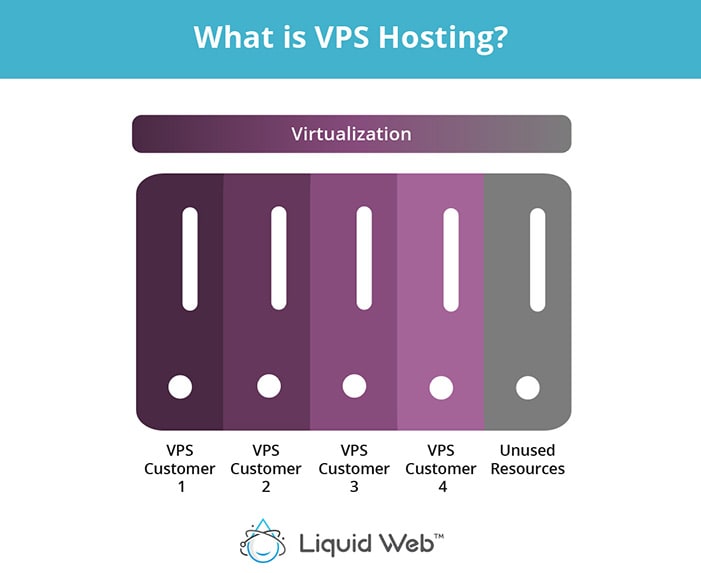
In computing, a single, physical server can be segmented into multiple isolated and individual virtual servers through some form of software. Each of these virtual servers is fully capable of independently running its own operating system (OS).
Among other reasons, this is done primarily for tighter controls over all server users. Server virtualization means that users can only access resources assigned to their unique instance.
For example, users on a virtualized server can’t identify the total number of operating systems, processors, or other virtualized servers on the physical server.
Additionally, they can only use the maximum memory or CPU cycles associated with their instance, preventing them from affecting other users on the server.
How Server Virtualization Works
Servers are computers that process requests from other computers within a network. Classically, one server is dedicated to one task or application. Considering just how many tasks and applications there are, this can add up to an unmanageable number of servers within one network.
Servers take up space and power to run. What’s more, some modern servers have more resources (memory and storage) than they need to handle the dedicated tasks or applications required. This underutilization of computing power across many servers can end up using far more energy than is necessary. Essentially, servers need to be managed in a way that allows for efficient energy consumption without sacrificing computing capabilities.

Server virtualization mitigates server inefficiencies by using software to divide a single physical server into multiple fully isolated virtual servers. Each of those virtual servers is capable of running independent operating systems and completing tasks by dividing up the resources across the parent server.
Benefits of Server Virtualization
Virtualization can greatly benefit an organization. In addition to streamlining network needs, server virtualization benefits include:
- Saving Space: If you’re running one task or application per server, they will soon take over your data center. By hosting multiple virtual servers on fewer physical servers, you can potentially save a lot of physical space.
- Lowering Hardware Costs: Building physical servers can be costly. Virtual servers are much less expensive to deploy.
- Improving Resource Efficiency: Many servers are more powerful than needed for the demands they are tasked with, meaning organizations technically pay for unused resources. Virtualization helps ensure that all resources are being efficiently used.
- Lowering Energy Costs: Since virtualization allows you to efficiently use server resources rather than build unnecessary infrastructure, you have fewer servers using energy.
- Decreasing Demand on IT: Maintaining a large network of physical servers can be taxing on an organization’s IT department. Virtualization can help free up IT worker resources to concentrate on other needs of the business.
- Speeding Up Setup: Days or weeks can go by between purchasing hardware for physical servers and implementation. Setting up virtual servers can take minutes.
- Simplifying Recovery: Backup systems on virtual machines (VMs) are quick and efficient. This means you can get up and running after a system failure fast with little to no data loss.
Drawbacks of Server Virtualization
Not everything is perfect with server virtualization. Some drawbacks to virtualization include:
- Increasing Upfront Costs: Any new hardware and licensing fees can add up to higher upfront costs.
- Slightly Decreased Performance: With resources shared, especially with hypervisor-based virtualization, users might see a slightly poorer performance. Tasks could take a little longer to run. However, with advances in server virtualization technologies, this is becoming less of an issue.
- Server Sprawl: Because VMs are relatively easy to build, admins can unintentionally overbuild the network, which is known as VM sprawl. When only 10 servers could suffice, 20 VMs could be built.

5 Types of Server Virtualization
Server virtualization is widespread as a solution across organizations and industries. This is because it solves some big problems like managing server resources, saving on infrastructure costs, and alleviating demand on IT. There are several types of server virtualization that network administrators rely on. Types of server virtualization examples include:
- Full virtualization.
- Para-virtualization.
- Hardware-assisted virtualization.
- OS-level virtualization.
- Hypervisor virtualization.
1. Full Virtualization
With full virtualization, a type of software called a hypervisor splits up the server’s resources between completely independent virtual servers that are isolated from each other. The hypervisor handles how resources are allocated between each virtual server. Since the virtual machines are separate, they all run on their own operating systems and can be configured as needed.
2. Para-Virtualization
Para-virtualization is somewhat related to full virtualization in that a hypervisor can access virtual machines through interfaces that are highly similar to the underlying hardware. Prior to installation inside a virtual machine, para-virtualization involves modifying a guest operating system to allow all other guest OS on the server to share resources and communicate with one another. Because all the VMs are working together, there are fewer demands on the hypervisor, meaning more of the virtualization server’s resources are dedicated to the virtual servers.
3. Hardware-Assisted Virtualization
With hardware-assisted virtualization, the division of resources needed to support multiple VMs is already built into the CPU of the host server. This allows virtual machines to communicate directly to the main server rather than entirely through the hypervisor. It’s a way to partially cut out the middleman, though a hypervisor is still needed. Since the path between the virtual machines and the physical server is more direct, the hypervisor uses a very significant amount of the server’s resources. This makes it seem like the virtual machines are running directly on the server.
4. OS-Level Virtualization
With full virtualization, para-virtualization, and hardware-assisted virtualization, a hypervisor is needed to provide a platform on which virtual servers’ operating systems can run. With OS-level virtualization, however, the host server’s operating system is set up to allow for multiple instances of virtual machines called containers. The VMs operate in much the same way in OS-level virtualization as in hypervisor virtualization, but the computing overhead of the host operating system is a much higher percentage of the physical server’s resources than in a hypervisor-based system. However, OS-level virtualization can be simpler and less costly for a new user to implement.
5. Hypervisor-Based Virtualization
With hypervisor-based virtualization, software (the hypervisor) virtually emulates the hardware of the main server, basically acting like the physical machine on which operating systems can run. The hypervisor allocates resources of the physical server across the various guest virtual machines.
Full virtualization and para-virtualization are types of hypervisor-based virtualization. Hardware-assisted virtualization is a type of hybrid virtualization that is hypervisor-based as well as hardware-based.
Server Virtualization: What to Consider
Virtualized servers can help improve an organization’s computing systems in multiple ways. They allow IT to concentrate less time on the internal network, save space in the data center, maximize server resources, and cut costs associated with hardware and energy. On top of all that, setting up a virtual machine is much simpler than setting up a new physical server.
However, server virtualization is often associated with shared server resources or multi-tenant solutions. While multi-tenant servers are more cost effective and can be very powerful, they are often associated with possible challenges like noisy neighbors and additional security or stability issues.
One way to mitigate these risks is to choose a bare-metal virtualization approach. With bare metal virtualization, you are the single tenant using the server’s resources, even though there is still a hypervisor managing the virtual servers. Bare metal virtualization can give you all the benefits of cloud computing while minimizing the risks associated with shared server configurations.
Liquid Web Knows Virtualization
While it’s possible to set up your own hypervisor or OS-level virtualization in your local server room, you don’t have to run your virtual machines on your own private on-premises physical servers. Liquid Web offers a variety of hosting options to fit your needs.
At the entry level, you could select a traditional bare metal server and install your own virtualization software. If you need a simple path to taking advantage of bare metal virtualization, our bare metal cloud servers offer single-tenant virtualized servers, giving you the power and performance you need in one package.
If you need the ultimate solution for performance and flexibility, Liquid Web’s VMware Private Cloud will provide you with everything you need. From load balancing to DDOS protection and High Availability Databases, you will have an industry-leading, enterprise solution at your fingertips.
Reach out to one of our Solutions Experts today to start taking advantage of the power of virtualization for all your server hosting needs.
[ad_2]
Source link






